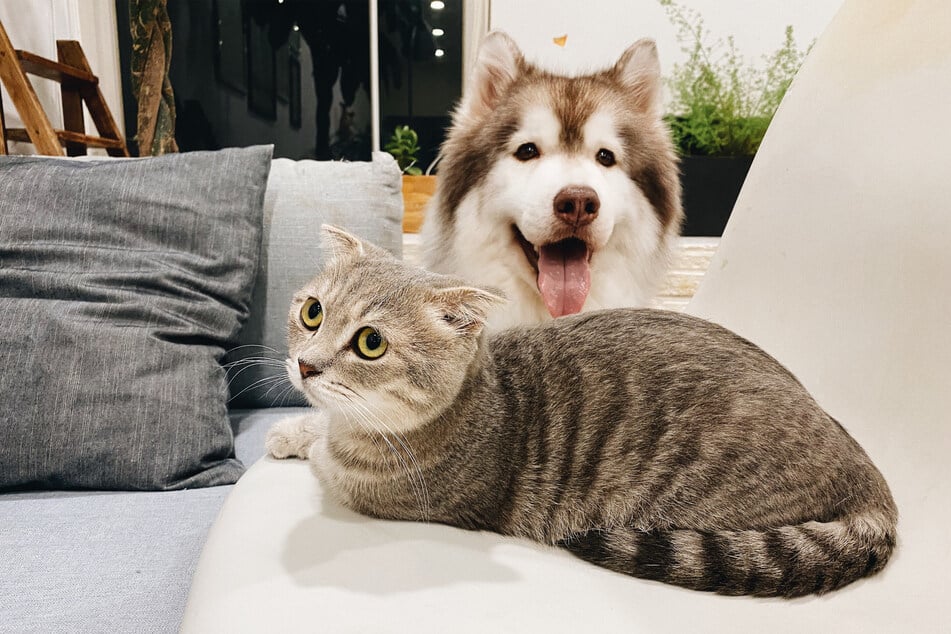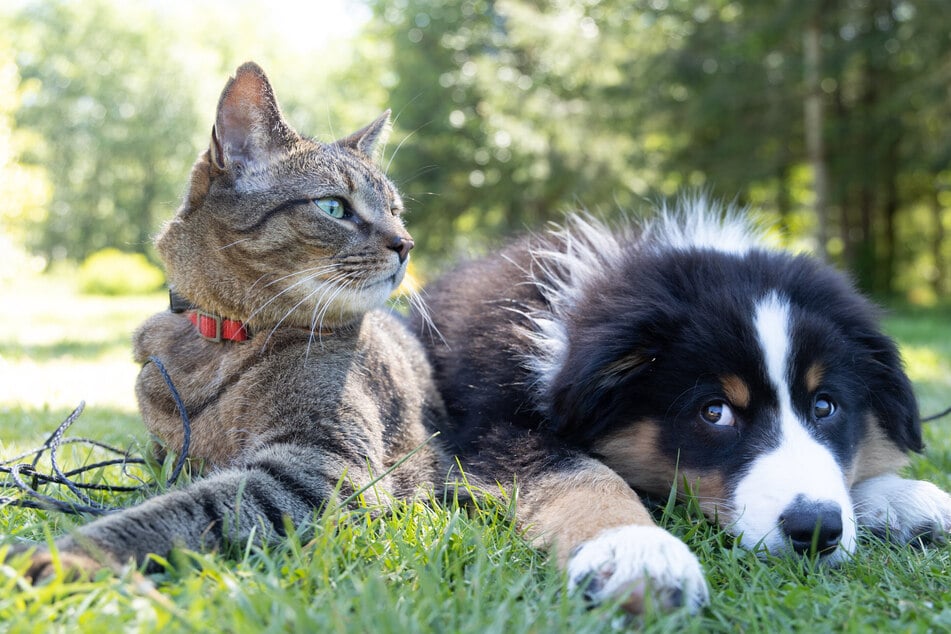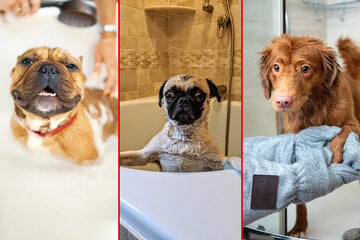How to introduce a dog and cat, and how to help them get along
Introducing dogs and cats can be incredibly challenging, but it's far from impossible. In fact, if you get it right, it can lead to a lifelong friendship and an incredibly happy family! Here's how.

Cats and dogs famously don't get along. The barking, the growling, the hissing, the spitting, everything that we associate with a cat meeting a dog is negative.
But things really don't have to be this way. We can, in fact, all just get along! It's perfectly possible to raise dogs and cats together, forming an unbreakable and loving bond.
In this guide, TAG24 will take you through how best to introduce a cat and a dog to one another.
How can you tell if a dog and cat will get along, how can you get them to bond, and what do you need to know? Let's find out!
How to introduce a cat and dog
The first meeting of your cat and dog should be extremely well thought through and very carefully orchestrated. There are a variety of things that need to be organized and prepared beforehand, and it's important to have a good understanding of each animal's personality and temperament.
Here are a few things to do when introducing your cat and dog:
- Make sure that you familiarize each of them with the other animal's scent. Do this by sharing blankets and pillows between them. If your cat snoozes on a blanket, give it to the dog, and vice versa.
- Each animal should be allowed to explore their new home by themselves for a while. So, if you already have a cat and you are introducing a doggo, put the cat in a hotel for a while and let your dog explore and get used to its new home.
- In some circumstances, it is good to play the sound of each animal to the other from time to time, to help make their acquaintance. If you have them in two rooms, it will help if they can hear each other through the walls or door.
- Before meeting each other for the first time, make sure that they have both eaten and are feeling a little lazy and as relaxed as possible.
- Before bringing the dog in to meet the cat, take it for a very long and exhausting walk, so that it is tired and less active.
- Keep your home as quiet as possible, with as few people as you can afford. Try to make sure that there are two people present, though, one for each animal if something goes wrong.
- Cats and dogs are both very sensitive animals, so make sure that there are limited distractions, nothing scary going on, and your home has a generally positive vibe when you begin the process.
- Try to keep your dog on a leash at the start, as it is the more physically powerful one and if there is an altercation, it will be harder to control.
Introducing a dog and a kitty to each other is very similar to introducing two cats. Keep them at a distance at first and take things slowly, in stages. It is also a very good idea for the dog to be well-trained before the interaction.
Important: No matter what you do, do not let either animal attack the other. This will severely damage their relationship from an early stage, and will cause tons of problems.
How to know if a dog and cat will get along
The rivalry that exists between dogs and cats are more than just a symptom of their domestication. These beautiful mammals descended from wild creatures that were constantly at each other's throats before humans even entered the picture. As a result, a peaceful coexistence is not just difficult to achieve, but unnatural.
On top of this historic rivalry, cats and dogs communicate very differently. While cat body language is done through subtle flicks and widening eyes, dogs go for more bombastic and excitable behaviors. As a result, a cat's habit of staring and flicking will seem aggressive to a dog, and a dog's excitement will seem aggressive to a cat.
Your best bet for getting a dog and a cat to coexist and live together is to simply bring them up from a young age in each other's presence. If it is possible, get a kitten and a puppy, and have them grow up as siblings.
That doesn't, however, mean that you can't get a cat and dog to get along when they are introduced as adults. The trick here is to own a very docile cat and a very relaxed dog, do it all over a long period of time, and make sure that neither of your pets are at all violent or suspicious.

How to get a dog and cat to bond and get along
The process of introducing adult cats and dogs to one another is a slow and carefully directed one. You need to get them to the stage where they will accept each other as housemates. It's a lot hard to get them to bond, so your first job should simply be to just get them living peacefully side by side.
Following are seven tips to help get your cat and dog to get along. If you follow these suggestions, they will become the best of friends.
Tip 1: Characters must fit together
The first thing to do is make sure that your cat and dog have similar characteristics. They both need to be relatively docile, calm, happy, relaxed, and non-aggressive. If you have an excited dog and a calm cat, the cat's going to get scared, and the dog won't like its new buddy.
These two little fluff balls don't necessarily need to be relaxed, though. An active cat will potentially pair quite well with a hunting dog or a dog that wants to explore and has a high level of intelligence. They just need to be similar to one another, and not have two contrasting personality types.
Tip 2: Consider breed characteristics
Certain cat breeds are better for pairing with dogs. We specifically focus on cats here because they are generally the ones with a problem, not the doggos. There are a vast assortment of cat breeds that generally get along better with dogs. More often than not, these are some of the larger cat breeds out there.
Here are a number of dog-friendly cat breeds to consider:
- Abyssinian
- American shorthair
- Balinese cat
- Bengal
- Burmese
- Carthusian
- Maine Coon
- Norwegian forest cat
- Ragdoll
- Siamese
- Siberian cat
- Turkish angora
Tip 3: Age
Again, we're going to sound like a broken record here, but it is best to bring a cat and dog together at similar ages. Now, this doesn't necessarily mean that it needs to be a kitten and a puppy, but simply two animals that are around the same stage of their life.
An old cat won't get along with a young and energetic doggo, and an old doggo will feel very intimidated by a cat that has matured but is in the prime of its hunting life. Indeed, these situations can lead to danger for both parties, as injuries can come from such a discrepancy.
Tip 4: Separate feeding places

You must make sure that your cat and your dog have different feeding places, bowls, and water. This is not just because cats and dogs eat different things, but also because there is an ever present threat that one of them is going to steal the other one's food or water.
Such a situation could cause illness (again, cats have different diets to dogs), but also discontent between the two of them. You don't want them to see each other as rivals, as this will create a sense of competition that will worsen their relationship. If your dog feels like it needs to protect its food from your cat, potentially dangerous situations can ensue.
Tip 5: Offer retreat possibilities
Cats and dogs need to time to adjust to one another, and will get extremely exhausted and irritable if they have no escape. As a result, cats in particular should be given a space which the dog won't be able to access. The bedroom is a good example, as you don't want your dog sleeping with you anyway.
The idea here is to provide a sanctuary where the cat (or the dog) can feel safe in the knowledge that it is away from its new doggo friend. This may not be necessary forever, but at the start of their relationship it is incredibly important. After all, there's a reason that we humans don't move in immediately with our significant others. We need space.
Please note: The reason why cats need a retreat more often than dogs is about more than just their personalities. Dogs will generally be able to go on walks with their humans, providing for some bonding time and a little release. Usually this is not possible for cats, especially indoor cats.
Tip 6: Be patient
Patience is absolutely crucial, especially if you want to avoid cat anxiety and similar issues with your doggo. Take it slow, introduce them for a few minutes at a time and then a few hours, and only keep them permanently together once they are used to each other. Be happy once you get to this stage, and allow time to forge a closer bond between the pair.
Tip 7: Consult an animal psychologist and veterinarian
Veterinarians are incredibly important throughout this whole process, as are animal psychologists. They should be consulted every step of the way to make sure that both animals are healthy, mentally fit, and doing okay. You need to allow for the possibility, though, that things won't go to plan.
This pairs with patience, because cats and dogs are very different animals and will take different amounts of time to adjust. By talking with your animal psychologist and vet, you will be able to come up with various exercises to help get them to bond and feel happy and comfortable with one another.
Be sensitive when trying to introduce a dog and cat
We might seem like a broken clock when repeating the fact that cats and dogs don't traditionally get along, but that's because it is true. They are not natural friends and, if you want them to coexist, they need to be introduced and bonded slowly, calmly, and in a sensitive and careful way.
Indeed, if you want your cat and dog to become actual friends, it's going to be hard unless they have grown up together from a young age. Don't despair, and get plenty of professional advice – it's hard work, but it's worth it!
Cover photo: Unsplash/Yan Laurichesse




